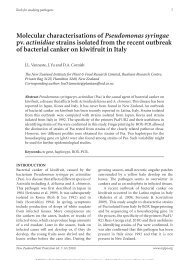field assessment of herbicides to release native plants from weeds
field assessment of herbicides to release native plants from weeds
field assessment of herbicides to release native plants from weeds
You also want an ePaper? Increase the reach of your titles
YUMPU automatically turns print PDFs into web optimized ePapers that Google loves.
Weeds <strong>of</strong> the Natural Environment 371<br />
TABLE 3: Mean scores <strong>of</strong> <strong>native</strong> plant health (0 = very healthy, 10 = dead) despite<br />
presence <strong>of</strong> <strong>weeds</strong> and <strong>herbicides</strong> applied around the base <strong>of</strong> the <strong>native</strong><br />
species newly planted in<strong>to</strong> grassland. These measurements were made<br />
15 weeks after <strong>herbicides</strong> were applied. Blank spaces indicate the<br />
treatment was not assessed on that species.<br />
Treatment Koromiko Ribbonwood Manuka Toe<strong>to</strong>e Purei Flax<br />
untreated 2.8 4.3 3.5 3.5 4.0 4.0<br />
glyphosate (shield) 2.0 1.0 1.3 1.0 2.5 3.3<br />
glyphosate (no shield) 1.3 2.8 4.5 3.8 3.5<br />
haloxyfop 1.8 3.3 0.3 4.8 3.3 3.0<br />
haloxyfop + clopyralid 1.8 2.3 0.1 2.8 3.3<br />
haloxyfop + aminopyralid 1.8 4.5 1.5 2.0<br />
haloxyfop + simazine<br />
(low)<br />
2.8 1.3 0.8 1.8 2.8<br />
haloxyfop + simazine<br />
(high)<br />
1.5<br />
terbuthylazine 5.3 2.5 5.8 4.5 4.3<br />
haloxyfop +<br />
terbuthylazine<br />
4.8 1.8 7.8 3.5 3.0<br />
dichlobenil 2.8<br />
metsulfuron (low) 4.5 3.8 6.0<br />
metsulfuron (high) 4.0<br />
amitrole (low) 5.0<br />
amitrole(low) +<br />
metsulfuron (low)<br />
6.0<br />
amitrole (low) +<br />
aminopyralid<br />
6.3<br />
amitrole (high) 5.8<br />
LSD (P=0.05) 1.8 1.6 4.5 3.3 2.6 2.2<br />
Glyphosate was also applied without a shield <strong>to</strong> all species except purei, as Carex spp.<br />
are known <strong>to</strong> be highly susceptible <strong>to</strong> glyphosate (Harring<strong>to</strong>n & Schmitz 2007). This<br />
treatment was sprayed up <strong>to</strong> the base <strong>of</strong> each plant, which meant that basal parts <strong>of</strong> each<br />
plant were covered with herbicide. For species such as ribbonwood and mountain flax,<br />
which were large at the time <strong>of</strong> treatment due <strong>to</strong> being 16 months old, there was little<br />
damage <strong>to</strong> the <strong>plants</strong>, as only a small proportion <strong>of</strong> each plant was sprayed. However,<br />
although manuka sustained little damage <strong>from</strong> exposure <strong>to</strong> glyphosate in a pot experiment<br />
by Harring<strong>to</strong>n & Schmitz (2007) when <strong>plants</strong> were 9 months old and 80 cm tall, the<br />
manuka in the present trial was only 4 months old and 30-40 cm tall, thus was more<br />
susceptible <strong>to</strong> this treatment.<br />
© 2009 New Zealand Plant Protection Society (Inc.) www.nzpps.org Refer <strong>to</strong> http://www.nzpps.org/terms_<strong>of</strong>_use.html




